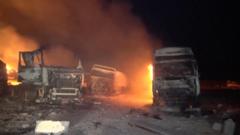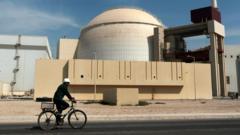Amid a hastily orchestrated retreat, Iran's abandoned military bases in Syria tell the story of a once-prominent presence now reduced to debris, highlighting the rapid decline of Tehran's influence in a transforming geopolitical landscape.**
The Collapse of Iran’s Military Footprint in Syria: A Strategic Retreat Unveiled**

The Collapse of Iran’s Military Footprint in Syria: A Strategic Retreat Unveiled**
Evidence of Iran's rapid military withdrawal from Syria is revealed as abandoned bases lay in ruins, embodying a narrative of panic and a shift in regional dynamics.**
After years of military expansion, Iran's former bases in Syria reveal a dramatic collapse of its strategic foothold, now lying in ruins. The remnants of these sites tell a tale of disarray: meals left unfinished, military clothing discarded, and weapons abandoned in the chaos of a quick retreat. Forces stationed at these locations fled abruptly, marking an end to a decade of deep-rooted presence that now dissipated in mere weeks.
For more than a decade, Iran stood as the most vital ally to Syrian President Bashar al-Assad, deploying military advisers, rallying foreign militias, and committing substantial resources to support the war in Syria. The elite Islamic Revolutionary Guard Corps (IRGC) established intricate networks of underground bases, arming and training thousands in their quest to form a "security belt" aimed primarily against Israel.
The abandoned base near Khan Shaykhun in Idlib province serves as a stark reminder of the recent past. Its entrance blends into the rugged terrain, camouflaged by sand and rocks, while a watchtower, still adorned with the colors of the Iranian flag, looms nearby. The base, once known as "The Position of Martyr Zahedi" in honor of a prominent IRGC commander, reveals remnants of its last daily operations—receipts for food supplies and personal items left carelessly scattered.
As insurgent groups move in, new occupants—armed fighters from Hayaat Tahrir al-Sham (HTS)—now inhabit the base. Encountered by our team, these fighters reported that the previous Iranian forces fled without a trace. Grappling with the aftermath of the retreat, their discovery of documents left behind contains sensitive personal details of fighters, affirming Iran's heavy reliance on Afghan forces in its military endeavors in Syria.
The retreat from these bases was not premeditated; as confirmed by Iran-linked sources, stark orders to evacuate were issued by command just in time to avoid direct confrontation. Such swift developments unfolded following a surge in Israeli air strikes and heightened conflict involving Iranian allies in the region, further dismantling the once-stalwart presence of the IRGC and its supporters.
As the IRGC and Hezbollah faced significant blows, internal rifts between Syrian officials and Iranian factions contributed to their downfall. Disillusionment among Tehran-backed groups fueled mistrust, further exacerbating a fragile alliance. Concurrently, sentiments among the local populace shifted, with many distinguishing between the oppressive Iranian presence and the more distant Russian military engagement.
Evidence of this shifting tide is apparent as the new Syrian leadership outright rejects the Iranian influence. The newly established authorities have implemented restrictions against Iranian nationals, opting for a more amiable stance with Russia, indicating a broader reconfiguration in regional power dynamics.
The abandoned bases stand as bittersweet relics of Iran's once-expansive military aspirations. Signs of military expansion linger, with evidence of construction ongoing until the last moments of the Iranian presence. Casualties of a rapid transformation, these remnants symbolize the profound loss of Iran's grip over Syria—a narrative now reshaped by local sentiment and international relations.
In stark contrast to their previous ubiquity, the Iranian military presence is now unwelcome, echoing the larger story of Iran's unraveling influence across the region.




















